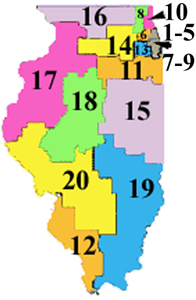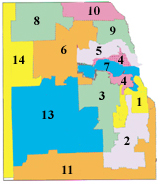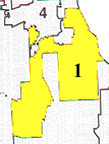| Illinois' Political Lineup
|
Redistricting Deadline The deadline for the legislature to enact state legislative districts is May 31, 2001 or October 5, 2001 for the commission. There is no congressional deadline. | Who’s in Charge of Redistricting? The legislature. If the May deadline is not met, an eight-member commission will draw the plan. If the Redistricting Commission fails to file an approved plan by the September deadline, the state Constitution requires that a ninth tie-breaking member of the panel be chosen by lottery from the names of a Republican and a Democrat submitted by the state Supreme Court. The Governor has veto power over both congressional and state legislative district plans. | ||||||||||||||||||||||||
Districting Principles
| Public Access There are no statewide public hearings specifically for redistricting plans. The public has the same access to the redistricting process as it would with any other bill.In addition, the Speaker of the House has a website for redistricting with a schedule of hearings, and proposed districts. | ||||||||||||||||||||||||
Political Landscape The Illinois method of redistricting consistently favors one party dramatically over the other. In the ‘80s it was the Democrats, in the ‘90s the Republicans. Illinois lost a congressional seat in the 2000 reapportionment once again. Democrat Luis Gutierrez’ Hispanic-majority 4th district may be especially vulnerable for being redrawn. | Legal Issues In 1991, the legislative district map approved by a Republican majority of the Illinois Redistricting Commission was challenged in state court as violating certain state constitutional requirements. The court upheld the plan. Minority voters in the state also challenged legislative districts on Equal Protection and 15th Amendment grounds. A federal district court upheld the same plan after finding no discriminatory purpose or effect. The Illinois legislature failed to redistrict its congressional delegation after losing a seat in the 1990 census. Thus, an action was brought in U.S. district court in 1992 claiming that the use of the existing plan for election was unconstitutional due to malapportionment. The court adopted a Republican proposed plan based on its adherence to equal population and compliance with other legal principles. After Shaw was decided in 1995, the federal district court approved plan fell under scrutiny again. Specifically, the 4th congressional district, a majority Hispanic district, was challenged as an unconstitutional racial gerrymander. The court decided that although the district was indeed a racial gerrymander, it served the compelling interest of the state of Illinois in redressing past vote dilution of Hispanic voters. | ||||||||||||||||||||||||
Legislation/Reform Efforts The contentious partisanship of the redistricting process in 1981-82 and 1991-92 has contributed to serious discussion of reform. A commission was formed in the mid-decade to study the problem, but there was no consensus proposal. In 1999, there was a proposed joint resolution which would have amended the state constitution to ensure that each house draws its own district lines separately. It would have abolished the Redistricting Commission. If no plan could pass by the required three-fifths vote, then state board of elections would use its districting computer program to generate a random redistricting plan. This measure died in committee. A constitutional amendment proposed in 1999 and again in 2001 would restore cumulative voting for electing the state house of representatives. Cumulative voting, a semi-proportional election system used in three-seat districts, was used to elect the Illinois house from 1870-1980. A bi-partisan group of current and former public officials, led by former governor Jim Edgar and former Congressman Abner Mikva, recently studied the issue and recommended its return. |
|
Contact Information Dan Hagen Timothy D. Mapes |

 Chicago Area
Chicago Area 
